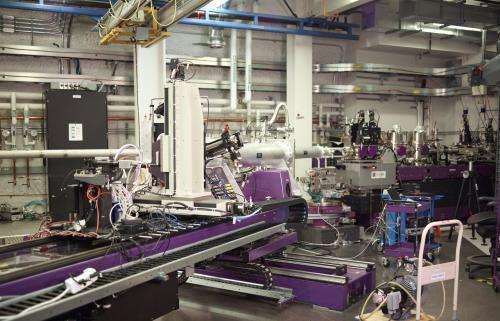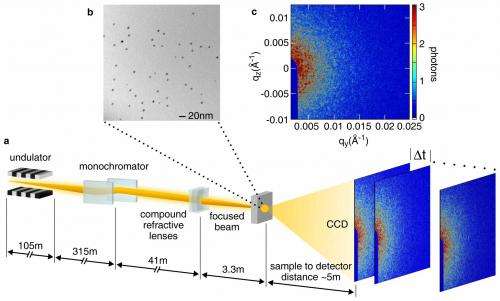Experiment shows potential of X-ray laser to study complex, poorly understood materials

Plastics are made of polymers, which are a challenge for scientists to study. Their chainlike strands of thousands of atoms are tangled up in a spaghetti-like jumble, their motion can be measured at many time scales and they are essentially invisible to some common X-ray study techniques.
A better understanding of polymers at the molecular scale, particularly as they are cooled from a molten state to a more solid form, could lead to improved manufacturing techniques and the creation of new, customizable materials.
In an experiment at the Department of Energy's SLAC National Accelerator Laboratory using SLAC's Linac Coherent Light Source (LCLS) X-ray laser, a DOE Office of Science User Facility, scientists unraveled the complex behavior of polystyrene, a popular polymer found in packing foams and plastic cups, with a sequence of ultrabright X-ray laser pulses. Their work is detailed in the Aug. 11 edition of Scientific Reports.
They measured natural motion in polystyrene samples heated to a gel-like middle ground between their melting point and solid state. This was the first demonstration that LCLS could be used for studying polymers and a whole range of other complex materials using a technique called X-ray photon correlation spectroscopy (XPCS),
Hyunjung Kim of Sogang University in Korea, who led this research, said, "It was unknown whether the sample would survive the exposure to the ultrabright X-ray laser pulses. However, the X-ray damage effects on the sample were weaker than expected."
SLAC staff scientist Aymeric Robert said, "To see how you get from something that was completely moving to something completely static is very poorly understood. Observations of how polymers move in response to temperature changes and other effects can be compared with theoretical models to predict their behavior." Robert oversees the experimental station at LCLS that is specially designed for this X-ray technique.

"LCLS should allow scientists to measure motion in these materials in even more detail than possible using conventional X-ray tools," he added.
To study motion in the heated samples, researchers embedded a matrix of nanoscale gold spheres into the polymer. Then, they recorded sequences of up to about 150 X-ray images on different sections of the sample, with the delay between images ranging from as little as seven seconds to as much as 17 minutes.

The XPCS technique measures successive "speckle" patterns that revealed subtle changes in the position of the gold spheres relative to one another – a measure of motion within the overall sample.
While many experiments at LCLS capture X-ray data in the instant before samples are destroyed by the intense light, this technique allows some materials to survive the effects of many X-ray pulses, which is useful for studying longer-lived properties spanning from milliseconds to minutes.

"We showed that we could study the complex dynamics in the polymer sample even at slow time scales," Kim said. While this experiment proved that LCLS can be used to measure the long-duration motions across the entire sample, Kim said future experiments could vary the arrangement and size of the implanted gold spheres to better gauge motion at the scale of the molecular chains. Also, faster repetition of the X-ray laser pulses could help to study motion on a shorter time scale.
More information: Jerome Carnis, Wonsuk Cha et al., Scientific Reports, 11 Aug. 2014 . DOI: 10.1038/srep06017
Journal information: Scientific Reports
Provided by SLAC National Accelerator Laboratory





















